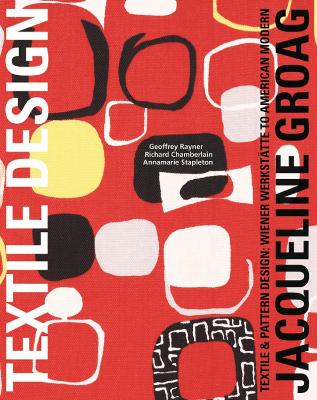Jacqueline Groag was probably the most influential textile designer in Britain in the post Second World War era. Although originally Czech, she studied textile and pattern design in Austria in the 1920s. During the late twenties and early thirties she designed textiles for the Wiener Werkstatte in Vienna and subsequently designed and produced unique hand printed lengths of fabrics for many of the leading Parisian fashion houses, including Chanel, Lanvin, Worth, Schiaparelli and Paul Poiret. She was awarded a gold medal for textile design at the Milan Triennale in 1933 and another gold medal for printed textiles at the Paris World Fair in 1937. Jacqueline was not only a serious and highly respected contender in the field of textile and pattern design but, with her husband, the Modernist architect Jacques Groag, was also deeply immersed in the intellectual life of Vienna.
In 1938 the sophisticated world of Jacques and Jacqueline was brutally shattered when the Anschluss, the political unification of Austria and Germany, occurred and the German army entered Vienna. Faced with the actuality of the Nazi terror the Groags, who were Jewish, fled to Czechoslovakia and their home city of Prague. After a brief respite they were once more forced to flee in 1939, this time to London. On their arrival in England they were welcomed and championed by leading members of the British design fraternity, amongst whom were Sir Gordon Russell, the doyen of British architects Sir Charles Reilly and Jack Pritchard, founder of the modernist design company, Isokon. Much of the Contemporary style of the textiles and wallpapers shown at the 1951 Festival of Britain were heavily indebted to Jacqueline's influential designs of the 1940s. Many examples of her work were featured prominently at the Festival and from then on she became a major influence on pattern design internationally. She developed a large client group in the United States during the fifties and sixties, amongst whom were Associated American Artists, Hallmark Cards and American Greetings Ohio.
In the later 1950s and throughout the 1960s she became increasingly involved with Sir Misha Black and the Design Research Unit (D.R.U.), working on the interiors for boats and planes and trains, particularly the design of textiles and plastic laminates for BOAC and British Rail. One of her last commissions from Misha Black, in the mid-seventies was a distinctive moquette for London Transport, for seating on both buses and tube trains. Her work and influence did not just extend to the large corporations and exclusive couturiers but was familiar to the general public through stores and companies such as John Lewis, Liberty of London, David Whitehead, Edinburgh Weavers, Sandersons, Warerite and Formica. Her remarkable achievement finally received public recognition in 1984 when, at the age of 81, she was made an R.D.I. - a Royal Designer for Industry - the ultimate accolade for any designer in Britain.
- ISBN10 1851495908
- ISBN13 9781851495900
- Publish Date 2 June 2015
- Publish Status Active
- Publish Country GB
- Publisher ACC Art Books
- Imprint ACC Editions
- Format Paperback
- Pages 184
- Language English
